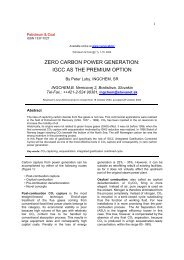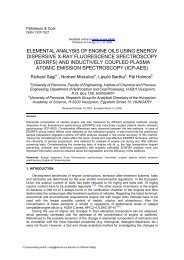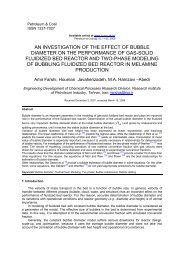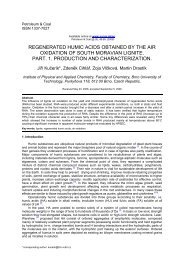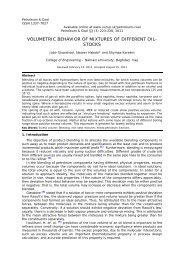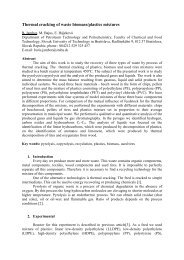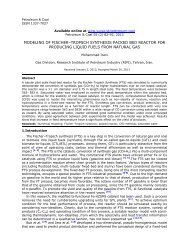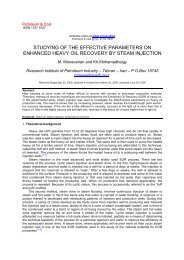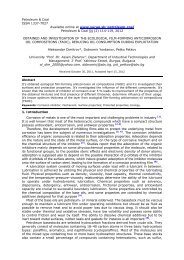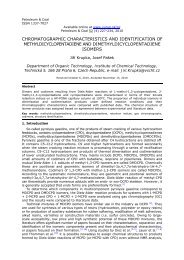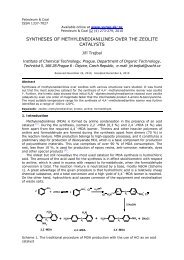MANAGED-PRESSURE DRILLING; TECHNIQUES AND OPTIONS ...
MANAGED-PRESSURE DRILLING; TECHNIQUES AND OPTIONS ...
MANAGED-PRESSURE DRILLING; TECHNIQUES AND OPTIONS ...
- No tags were found...
You also want an ePaper? Increase the reach of your titles
YUMPU automatically turns print PDFs into web optimized ePapers that Google loves.
M. R. Rohani/Petroleum & Coal 54(1) 24-33, 2012 31heavier fluid at the lower portion. This enables the pressure to remain in the pressurewindow between the pore pressure and fracture pressure [16] .To achieve a dual gradient, a less-dense fluid such as air, inert gas, or light liquid is injectedat a certain point in the wellbore. Introducing this less dense fluid at this point would decreasethe density of the fluid from that point up to the surface [16] . This technique is helpful as ameans of adjusting the effective bottomhole pressure without having to change base fluiddensity and with fewer interruptions to drilling ahead, usually to avoid lost circulation in athief zone or to minimize differential sticking of the drillstring. (Injecting Less Dense MediaMethod) [10] .Another technique is used for offshore environments. A small diameter return line is runfrom the seafloor to circulate the drilling fluid and cuttings. The marine riser is kept full of seawater.A subsea pump is used to lift the drill cuttings and the drill fluid from the wellboreannulus up to the rig floor. By using seawater in the marine riser, a more dense mud is usedin the wellbore to achieve the bottomhole pressure required. (Subsea Mudlift Drilling (SMD))The purpose of dual-gradient drilling is to prevent a large overbalance and prevent exceedingthe fracture gradient. Dual-gradient drilling allows the operator to manipulate the pressureprofile to prevent exceeding the fracture pressure at a point but still to remain above thepore pressure. It is basically being able to take a tight pressure gradient window and designa drilling plan to manipulate the pressure curve to fit into the window. Dual-gradient drillingcan also be achieved in deep water without a riser when first starting a subsea drilling location.A subsea RCD and remote operating vehicle are used. The ROV is able to adjust backpressureat the mudline by adjusting the choke. If the ROV closes the subsea choke, the BHP increases.This results in drilling with a slight overbalance as if a marine riser filled with drilling fluidwere present. The advantage of being able to drill with a slight overbalance is that it helps toprevent shallow gas or water flow. The seawater is used as the drilling fluid so the drillingfluid and cuttings can be left on the sea floor. Fig. 9 shows the pressure profile for this exampleand how adding the backpressure at the seafloor causes the pressure profile to equal thatwhich would be achieved by having a single gradient.Fig. 9.Pressure profile for Fig. 10. MPD rig up for Return Flow Control [12]drilling dual gradientwithout a riser [16]As far as well control with dual-gradient drilling is concerned, the detection criteria of a kickare very similar to conventional drilling. With dual-gradient drilling, pressure gauges installed onthe rig floor are more sensitive to changes than the gauges used in conventional drilling. Adecrease in circulating pressure caused by an increase in flow will be more easily seen. If akick occurs, the annular flow rate of the drilling fluid will increase by an amount equal to theinflux rate. If the subsea pump were set to operate at a constant inlet pressure, the subseapump rate would increase. This increase would be seen on the computers at the rig floor and



